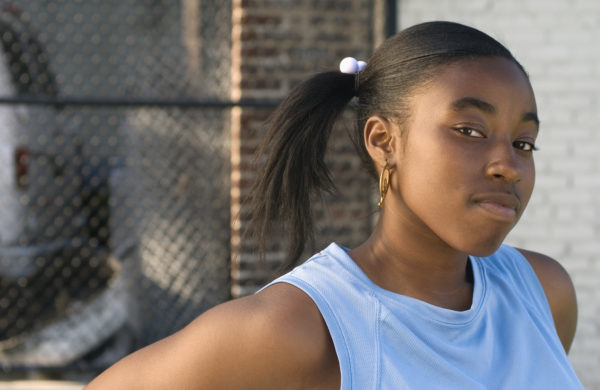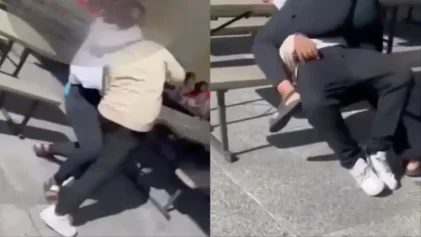A new study examining racist and sexist school dress codes found that Black schoolgirls are most impacted by the harmful policies — and are disproportionately dismissed from the classroom because of it.
The report, published by the National Women’s Law Center earlier this month, found that over half of Washington, D.C., schools regulated the lengths of shorts and skirts, while 48 percent of schools banned head wraps, hats and other head coverings, some of which have cultural or religious significance.

According to the report, many school dress codes had restrictions on leggings and mentioned tank tops or the width of sleeves. (Photo by Leland Bobbe / Getty Images)
Researchers surveyed students and parents across 29 public and charter schools in the area, 21 percent of which banned tights or leggings and 55 percent that regulated the tightness, sizing, and fit of clothing.
More telling was the fact that high schools with the most restrictive dress codes have a predominately Black student population, according to the study. Oftentimes, school grooming policies target clothes worn by female students, like spaghetti-strap tanks, crop tops and yoga pants.
“Black girls are impacted the most by these harmful policies, and they’re the ones leading the movement for change,” Adaku Onyeka-Crawford, the Director of Educational Equity for NWLC, said in a statement. “Their work should inspire [and] fuel school leaders across the country to confront this inequity and continue doing this vital work.”
As part of its report, the organization graded several schools on their dress code; the fewer the restrictions, the better grade it received. Out of the 29 schools surveyed, only 3 got an A rating. In contrast, nearly a dozen schools received a failing grade for having five or more dress code restrictions.
Jasmine Tucker, the NWLC’s director of research, called the outcome “unacceptable” and highlighted how these standards have a disparate impact on Black female students. For one, she said, African-American girls/women are often policed over their natural hair or other cultural hairstyles, which have been deemed “unprofessional” for work and/or school.
“Many schools ban head wraps or other head coverings and specify that hair must be ‘neat,’ which is another way of banning certain hairstyles,” Tucker told The Independent in a recent interview.
Moreover, Tucker pointed out that its often Black administrators who enforce these harsh policies because they feel “it’s necessary to prepare black students for a world that already views them as less innocent and more adult.”
“In actuality, restrictive dress codes and discipline policies reinforce anti-black stereotypes by telling black girls that their authentic selves are incompatible with academic success,” she explained. “Black girls deserve teachers and school leaders that are willing to challenge systemic racism and misogyny that have created barriers for too many students for too long.”
Discipline policies vary from school to school, with some sending students to in-school suspension for violating dress code while others handle it with detention or a call home to the student’s parents.
The report also found that female students are often subjected to victim-blaming, or are accused of inviting sexual harassment because of the clothes they’re wearing. Chloe Pine, student at School Without Walls High School, said this can be especially harmful to a girl’s self image.
“If you go to school every single day and a male teacher tells you that you are showing too much skin or that you look inappropriate, or that you are distracting other boys, you’re again embedding in their head that they have to live up to some certain standard that a male made,” Pine said. “And that is just not the way that society should be.”
The groundbreaking report comes one year after the NWLC’s initial study analyzing the effects of racist and sexist grooming policies at Washington schools. The report spurred action by students and parent across the country and in 2018 led to the Washington City Council approving a bill that would ban out of school suspensions for minor infractions, including dress code violations.


